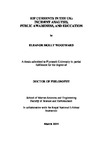Rip currents in the UK: incident analysis, public awareness, and education
| dc.contributor.supervisor | Beaumont, Emily | |
| dc.contributor.author | Woodward, Eleanor Molly | |
| dc.contributor.other | Faculty of Science and Engineering | en_US |
| dc.date.accessioned | 2015-08-19T16:48:58Z | |
| dc.date.available | 2015-08-19T16:48:58Z | |
| dc.date.issued | 2015 | |
| dc.date.issued | 2015 | |
| dc.identifier | 10172029 | en_US |
| dc.identifier.uri | http://hdl.handle.net/10026.1/3529 | |
| dc.description | Chapter 3 has been published as conference proceedings in the Journal of Coastal Research, and Chapter 4 has been published in the International Journal of Aquatic Research and Education | en_US |
| dc.description.abstract |
Rip currents present a severe hazard to water users worldwide, resulting in over 100 drownings and thousands of lifeguard rescues annually. This thesis examines the demographics of who is effected by rip currents in the UK, what activity they are undertaking, when and where incidents occur, how much the public know, what people have experienced, and how best to educate them. Analysis of 7909 rip current lifeguard rescues (16777 people) across the UK between 2006-2013 highlighted the most at risk group, and subsequent target audience for education, to be male teenagers aged between 13-17 years old (n=2906, 17%). Geographically, the highest incidents occurred on the beaches in the Southwest of England (n=6911, 87%). Incidents mostly occurred outside of lifeguard flagged areas (n=4302, 54%) and mainly involved those using bodyboards (n=5290, 52%). Through the analysis of 407 public beach-based rip current and beach safety questionnaires, it was established that beach users have a poor understanding of rip currents (n=263, 65%) but a good perception of the beach safety flags (n=389, 96%). People with greater knowledge were typically educated by a lifeguard, enter the sea more frequently or have been caught in rip currents themselves. The experiences of 553 people caught in rip currents were analysed using an online questionnaire. The gender split was 69% male (n= 382) to 31% female (n= 171), indicating that males are caught in rip currents more than females. Swimming directly to shore against the rip followed an initial panic (n=108, 34%) for most people caught in a rip. Swimming parallel to the beach was the most remembered, advised, utilised, and promoted safety message. Respondents advocated the use of lifeguards to disseminate rip current safety messages. A new and unique rip current education programme was developed from the synthesis of these results. A lifeguard delivered a pilot programme to 185 teenagers in three schools and two community groups in the Southwest of England. This interactive pilot consisted of exercises using videos, photographs, news reports, and a swimming machine. Levels of rip current knowledge were evaluated before and after, and at regular intervals, to assess knowledge retention. The short-term effects after 3 months were positive, showing statistically significant (p<0.0005) improvements in mean knowledge levels. This thesis provides a new contribution to the expanding field of social and behavioural rip current research. The development of a unique rip current education programme presents an alternative method for increasing public awareness, and supports the worldwide prevention of rip current incidents and fatalities. | en_US |
| dc.description.sponsorship | Royal National Lifeboat Institution and The Marine Institute | en_US |
| dc.language.iso | en | en_US |
| dc.publisher | Plymouth University | en_US |
| dc.subject | Rip current | en_US |
| dc.subject | Beach safety | en_US |
| dc.subject | Beach lifeguards | en_US |
| dc.subject | Public education | en_US |
| dc.subject | Questionnaires | en_US |
| dc.title | Rip currents in the UK: incident analysis, public awareness, and education | en_US |
| dc.type | Thesis | en_US |
| plymouth.version | Full version | en_US |
| dc.identifier.doi | http://dx.doi.org/10.24382/1321 |
Files in this item
This item appears in the following Collection(s)
-
01 Research Theses Main Collection
Research Theses Main


